Gorbals Pumping Station and Drumboy Hill DSR (2017)
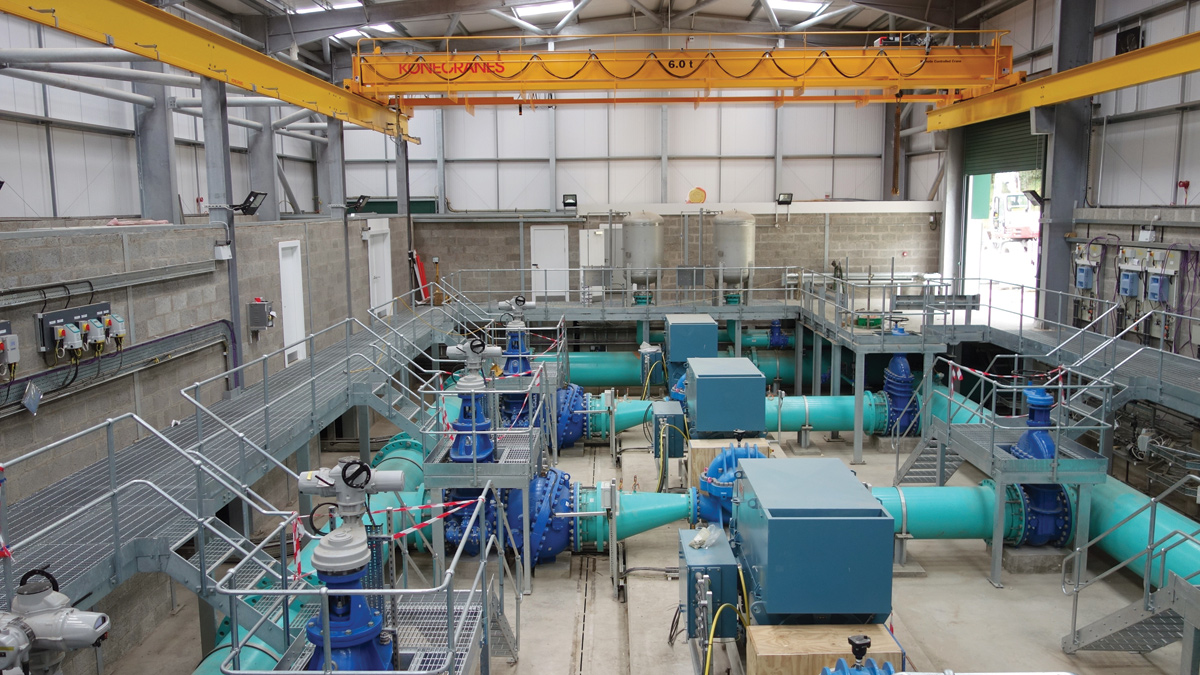
Gorbals Pumping Station - interior view - Courtesy of amey-Black & Veatch
Scottish Water has undertaken a £120m drinking water improvement scheme in Ayrshire to meet water quality compliance objectives and provide increased resilience of supply to five operational areas. The scheme involves the transfer of water from the Milngavie WTW located north of Glasgow to the Ayrshire region southwest of the city. The scheme makes use of existing assets in addition to construction of new assets to accomplish the objectives. The Gorbals Pumping Station and Drumboy Hill Distribution Service Reservoir (DSR) are key elements of the overall scheme being delivered by aBV, a joint venture between Amey and Black & Veatch (now Binnies). The interconnecting pipelines between the various sites are being undertaken by Caledonia Water Alliance (CWA) under a separate contract.
Background
The primary objective of the scheme is to address water quality non-compliance issues associated with Trihalomethanes (THMs), iron and manganese in the Amlaird, Corsehouse and South Moorhouse operational areas. To accomplish this objective the existing supply sources and treatment works are being removed from service and treated water from the newer Milngavie WTW will be supplied. In addition, the scheme will reinforce supply to the Picketlaw and Bradan operational areas, and facilitate the future introduction of additional supplies into the network from Highlees and Dalmacoulter to increase overall regional resilience.
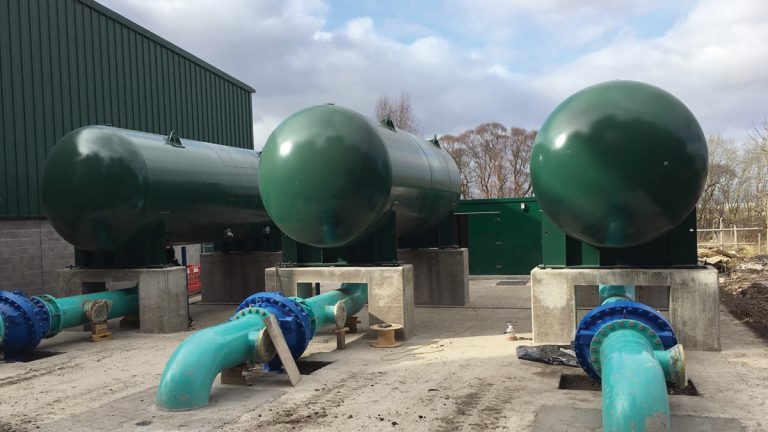
Gorbals Pumping Station surge vessels – Courtesy of amey-Black & Veatch
Gorbals Pumping Station
The Gorbals Pumping Station which is an 84ML/d booster station is the ‘engine’ for the overall scheme. The pumping station is located in the south of Glasgow adjacent to the existing Gorbals WTW at Darnley. Treated water from the Milngavie WTW flows by gravity to the existing Gorbals DSRs.
The Gorbals pumping station draws treated water from the existing DSR’s pumping it to the new Drumboy Hill DSR which is located at the highest point (elevation) in the system. Treated water then flows by gravity from the Drumboy Hill DSR to five operational areas.
The Gorbals Pumping Station features 3 (No.) 690V horizontal split case pumps manufactured by SPX Cathcart, Glasgow. The pumps, fitted with variable speed drives, operate in a duty/assist/standby configuration to produce 84ML/d against a system head of 21 bar. Each pump is rated at 1277kW at 1530 rpm. The electrical power supply to the existing Gorbals site was inadequate to accommodate this new load thus requiring development and construction of a new 11kV primary power feed to the site. Due to the need for operational reliability a second 11kV supply was also developed to ensure availability of backup power.
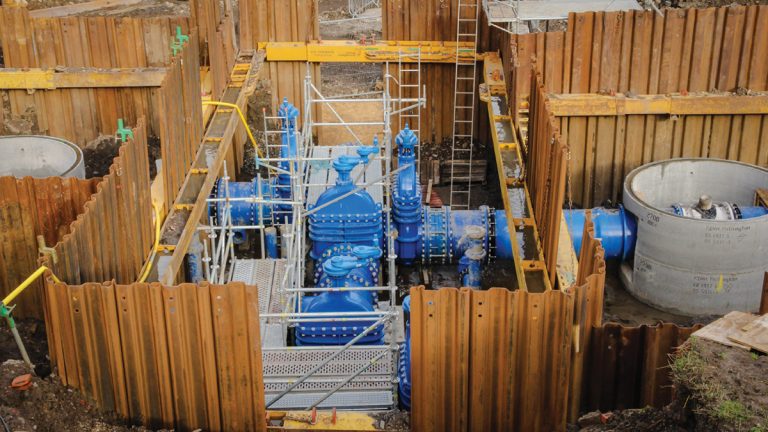
Gorbals DSR – construction of new valve station – Courtesy of amey-Black & Veatch
Although the Milngavie WTW provides high quality treated water, the distance from the WTW to the Ayreshire communities and associated residence time gives rise to potential for formation of disinfection by-products. To address this issue chloramination has been introduced as part of the Gorbals Pumping Station project through the addition of chemicals. To accomplish this, chemical feed facilities are housed within the pumping station building and include the following:
- Sodium hydroxide for pH adjustment.
- Sodium hypochlorite for secondary disinfection.
- Ammonia for the formation of chloramines.
The chemical feed systems were manufactured and assembled offsite by Lintott Control Systems Ltd, in accordance with Scottish Water’s new standard product solutions catalogue. This resulted in high quality standardised assemblies and enabled greater parallel path progress to reduce overall construction time on site.
Due to the high pressures involved in pumping treated water from the Gorbals site to the Drumboy Hill DSR the pumping station includes a surge protection system consisting of three 40m3 surge vessels limiting the maximum surge to 25 bar. Operational controls for the overall system is provided through a network of PLCs located at each operational site with internet based M2M communications to the SCADA ‘hub’ located at Gorbals.
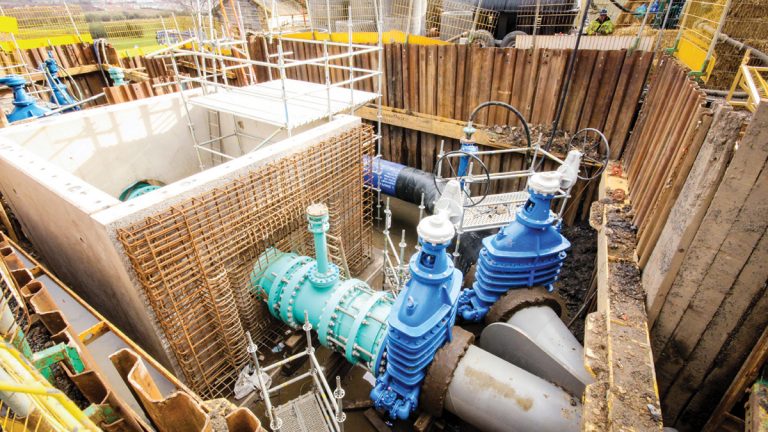
Gorbals Pumping Station – construction of discharge flow meter vault and bypass piping – Courtesy of amey-Black & Veatch
Initial site preparation works in advance of construction of the Gorbals Pumping Station commenced in May 2016. With limited space available on site for construction of the new pumping station access to the working areas and the logistics around material laydown and storage required careful planning. In addition, the temporary works required to make piping connections to the existing DSRs and associated construction of new flow meter and valve chambers required a carefully sequencing of the work.
Drumboy Hill Distribution Service Reservoir
The Drumboy Hill DSR is located approximately 14km south of Glasgow in a remote area to the east of the M77 near the Whitelee Wind Farm. The DSR is sited at an elevation of 260m above sea level which enables gravity supply to the operational areas. The DSR consists of 2 (No.) 1.6ML cells providing a total storage capacity of 3.2ML to the network. This volume provides a level of storage to balance changes in flow from the pumps and the distribution side as well as providing storage.
The DSR features a large integral valve chamber containing 14 (No.) actuated 900mm gate valves and network of cross connecting pipework. This complex arrangement was driven by the number of operational areas served and the future flexibility to reverse flows by pumping from the Highlees and Dalmacoulter operational areas back to Drumboy Hill, enabling gravity flow back to the Gorbals site. Operational control of all valves and appurtenances is via the Gorbals SCADA system ‘hub’.
Design and construction of the DSR structure was undertaken in collaboration with Carlow Precast (now FLI Precast Solutions). The DSR cells and valve chamber sit upon a cast-in situ reinforced concrete base. The walls are constructed of full height precast wall panels with cast in situ infill strips between adjacent panels. Panel heights for the cell walls are 7m. Panel heights for the valve chamber are 9m to accommodate the lower floor elevation. Roof construction consists of precast panels with a cast-in situ concrete topping slab and waterproof membrane.
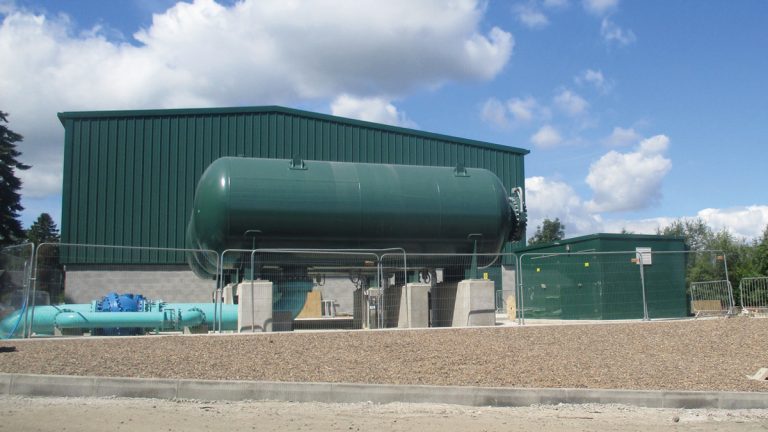
Gorbals Pumping Station – exterior view showing surge vessels – Courtesy of amey-Black & Veatch
Along with the DSR, the Drumboy Hill site includes three large metering vaults fitted with 900mm diameter bi-directional magnetic flow meters and 800mm bypass arrangements. The vaults are constructed of bespoke flat-pack precast structures.
The hilltop site posed many challenges for construction including limited access, difficult ground conditions and severe winter weather. The remote location could only be accessed via an existing single track country road used by nearby farms. Thus, a haul road had to be constructed to provide construction access for cranes and other construction equipment, delivery of materials, as well as for the workforce.
Also, the site contained a thick layer of peat overlying a sloping rock profile. This required a comprehensive peat management plan through the period of construction as well as rock excavation. In addition, the with the construction period spanning a portion of the winter in Scotland, the exposed hilltop site was subject to heavy winds, heavy rain and snowfall.
Conclusion
At the time of writing (July 2017) construction of the Gorbals Pumping Station and Drumboy Hill DSR are nearly complete and dry commissioning of the equipment and systems has been progressed to the extent possible. Wet commissioning is planned for September 2017 once the construction and testing of the remaining pipeline elements (by others) are complete. The target date for operation is 31 October 2017.







